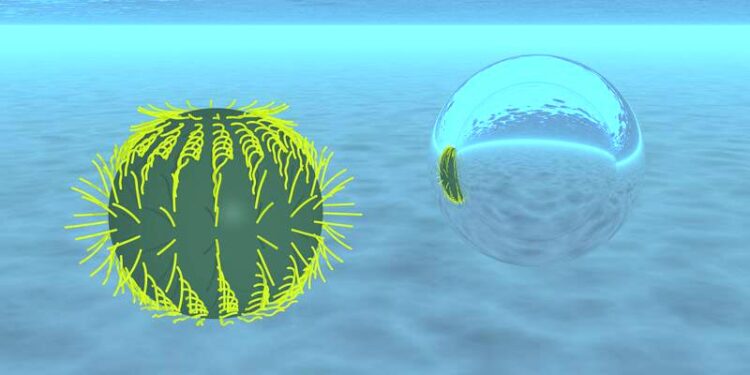Microswimmers can learn from bubbles how to swim efficiently

A microswimmer propelled by cilia (left) and an air bubble in water (right).
© MPIDS/Vilfan
Researchers at the Max Planck Institute for Dynamics and Self-Organization show that the secret to optimal micro-swimming is out there in the nature. They prove that a microswimmer can increase its swimming efficiency by learning the swimming techniques from an unexpected mentor: an air bubble.
Engineers have spent considerable efforts to improve the fuel economy of aircraft, cars or ships in the past decades. A similar process has been going on in biology, where swimming microorganisms have evolved over hundreds of millions of years to move efficiently. Many biological microswimmers like Paramecium use their small hair-like appendages to “slip” the fluid at their surface and gain locomotion.
This general swimming technique however comes at a high cost, since a large portion of the internal energy used for swimming often dissipates through the surrounding liquid and does not convert into mechanical work. So, it is of great interest to unravel what sort of swimming techniques (or slip patterns) are optimal and less dissipative.
In a study just published in Physical Review Letters, Babak Nasouri, Andrej Vilfan, and Ramin Golestanian from the Max Planck Institute for Dynamics and Self-Organization (MPIDS) show that the velocity patterns appearing on the surface of moving air bubbles are the key for reaching optimal swimming.
“The problem of optimal swimming at microscopic scales had been solved for a limited number of specific swimmers before” says Ramin Golestanian, the director of the Department of Living Matter Physics at the MPIDS, “But it is remarkable that there can be a simple theorem which explains optimal swimming for all the swimmers of different shapes and types.”
No longer an optimization problem
Previously, studying the energy dissipation and optimal swimming required rather computationally-expensive calculations, which had to be tailored for different shapes of the swimmers individually. However, the scientists demonstrate in their new study how to evade the conventional optimization calculations otherwise needed for finding optimal swimmers. Andrej Vilfan, group leader in the department, tells how the idea arose:
“We were thinking about simpler solutions. Once my children were playing in the sandbox, I had plenty of time to think about physics, but no pen and paper. You can see that in the solution: rather than complicated maths, it solves the problem by looking at the flow around an air bubble.” Babak Nasouri, first author of the paper, adds: “Thanks to the theorem, the achieved simplification in calculations allows us to explore the absolute limits of optimal swimming for any shape of swimmers.”
The theorem developed in this study proves that all optimal swimmers, regardless of their shape, must follow the same principle. They all should have the same slip profile as their bubble look-alikes. “Perfect-slip bodies, like air bubbles, waste the least energy while moving in a liquid. Hence an optimized swimmer should mimic the technique employed by these bubbles,” says Vilfan.
Microswimer efficiency can supersede Lighthill efficiency
The new theorem also presents the absolute minimum energy a swimmer can spend to reach a given swimming speed. Using this lower bound on energy dissipation, the authors propose a new measure for efficiency (called microswimmer efficiency) which can properly quantify the optimality of a swimmer.
Nasouri explains “The commonly-used criterion for calculating the efficiency, the so-called Lighthill efficiency, can lead to large numbers, which are unphysical. For instance, a needle-like swimmer can have efficiencies of more than 500%. But the microswimmer efficiency we propose never exceeds 100%, and so it is an excellent alternative to the Lighthill efficiency.”
The authors hope that their theorem paves the way for better understanding the energy expenditure in the motile microscopic world. “In addition to the energy dissipated in the liquid, microswimmers also spend large portion of their internal energy on generating the slip patterns. So, expanding our theorem to account for these internal dissipations, would be the next natural step” concludes Golestanian.
Wissenschaftliche Ansprechpartner:
Dr. Andrej Vilfan, Email andrej.vilfan@ds.mpg.de, Phone +49 551 5176-183
Originalpublikation:
Babak Nasouri, Andrej Vilfan, and Ramin Golestanian, “Minimum Dissipation Theorem for Microswimmers”, Physical Review Letters 126 (2021) 034503, DOI 10.1103/PhysRevLett.126.034503
Weitere Informationen:
Media Contact
All latest news from the category: Physics and Astronomy
This area deals with the fundamental laws and building blocks of nature and how they interact, the properties and the behavior of matter, and research into space and time and their structures.
innovations-report provides in-depth reports and articles on subjects such as astrophysics, laser technologies, nuclear, quantum, particle and solid-state physics, nanotechnologies, planetary research and findings (Mars, Venus) and developments related to the Hubble Telescope.
Newest articles

Innovative 3D printed scaffolds offer new hope for bone healing
Researchers at the Institute for Bioengineering of Catalonia have developed novel 3D printed PLA-CaP scaffolds that promote blood vessel formation, ensuring better healing and regeneration of bone tissue. Bone is…

The surprising role of gut infection in Alzheimer’s disease
ASU- and Banner Alzheimer’s Institute-led study implicates link between a common virus and the disease, which travels from the gut to the brain and may be a target for antiviral…

Molecular gardening: New enzymes discovered for protein modification pruning
How deubiquitinases USP53 and USP54 cleave long polyubiquitin chains and how the former is linked to liver disease in children. Deubiquitinases (DUBs) are enzymes used by cells to trim protein…


